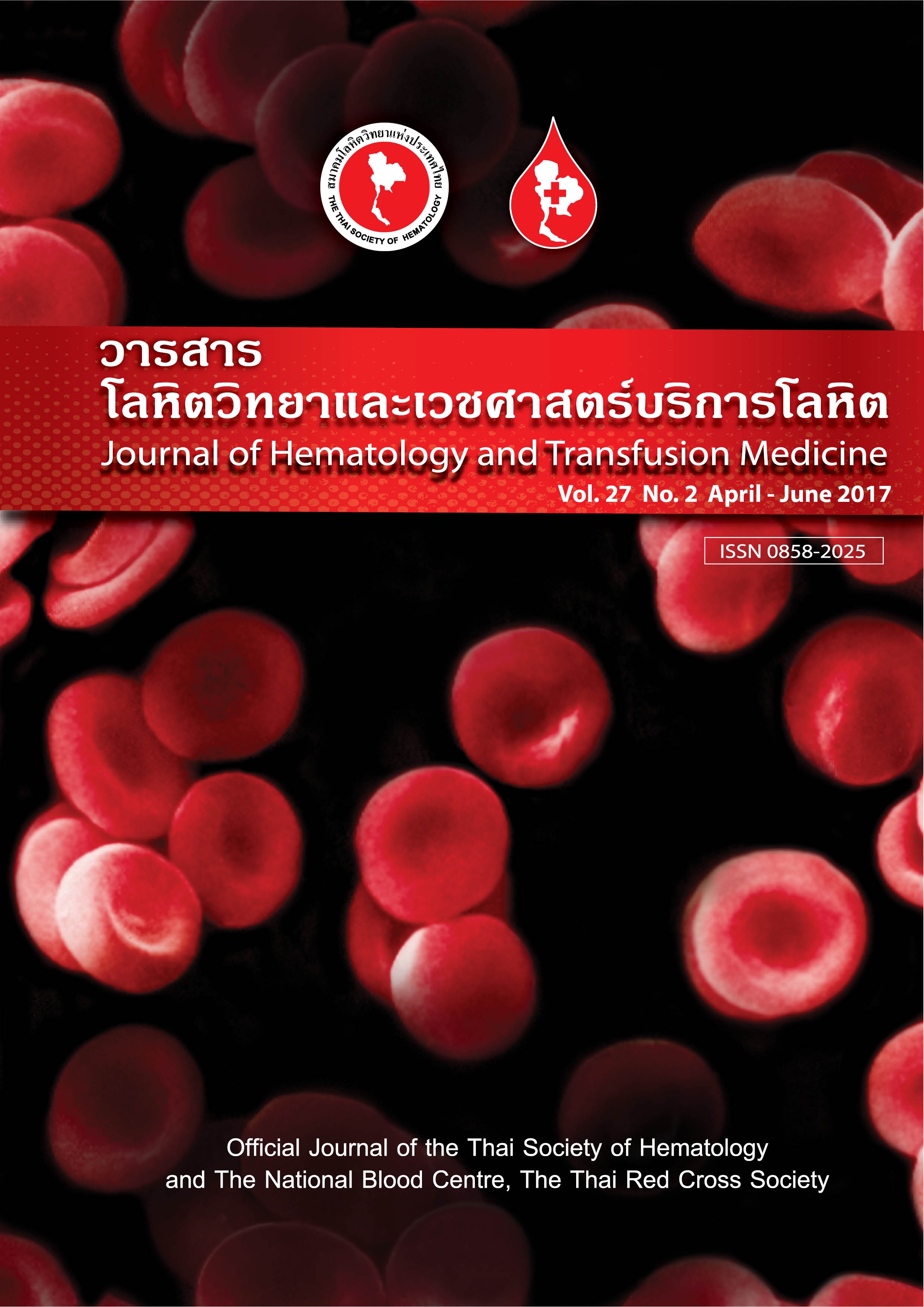โอกาสพบผู้บริจาคเซลล์ต้นกำเนิดเม็ดโลหิตที่ไม่ใช่ญาติของผู้ป่วยที่ขึ้นทะเบียนรอรับเซลล์ต้นกำเนิดเม็ดโลหิตจากศูนย์บริการโลหิตแห่งชาติ สภากาชาดไทย
Keywords:
Unrelated donor, HLA matching, Logistics regressionAbstract
บทคัดย่อ
การปลูกถ่ายเซลล์ต้นกำเนิดเม็ดโลหิตจากผู้บริจาคที่ไม่ใช่ญาติเป็นวิธีรักษามาตรฐานในผู้ป่วยโรคเลือดที่ไม่พบผู้บริจาคที่เป็นพี่-น้อง พ่อแม่เดียวกัน โอกาสที่ผู้ป่วยจะพบผู้บริจาคที่ไม่ใช่ญาตินั้นขึ้นอยู่กับหลายปัจจัย เช่น จำนวนผู้บริจาค หรือลักษณะบางอย่างของผู้ป่วย โดยยังไม่มีการศึกษาการทำนายโอกาสพบผู้บริจาคที่ไม่ใช่ญาตินี้ในประเทศไทย วัตถุประสงค์ เพื่อทำนายโอกาสที่ผู้ป่วยจะพบผู้บริจาคที่ไม่ใช่ญาติตั้งแต่แรกขึ้นทะเบียน และเพื่อหาปัจจัยที่สัมพันธ์ต่อโอกาสพบผู้บริจาคที่ไม่ใช่ญาติของผู้ป่วย วิธีการ วิเคราะห์โอกาสในการพบผู้บริจาคที่ไม่ใช่ญาติของผู้ป่วยตั้งแต่แรกขึ้นทะเบียนด้วยเทคนิคการวิเคราะห์การถดถอยโลจิสติค โดยศึกษาข้อมูลย้อนหลังแบบ retrospective cohort study จากแฟ้มประวัติผู้ป่วย ที่ขึ้นทะเบียนรอรับเซลล์ต้นกำเนิดเม็ดโลหิต ของศูนย์บริการโลหิตแห่งชาติ สภากาชาดไทย ระหว่างปี พ.ศ. 2554-2558 จำนวน 442 ราย ผลการศึกษา การวิเคราะห์ตัวแปรเชิงเดี่ยวพบว่า ผู้ป่วยวัยผู้ใหญ่ที่อายุตั้งแต่ 15 ปีขึ้นไปเมื่อขึ้นทะเบียนครั้งแรกมีโอกาสพบผู้บริจาคที่ไม่ใช่ญาติมากกว่าผู้ป่วยวัยเด็ก 1.7 เท่า (p = 0.008) ผู้ป่วยเชื้อชาติไทยมีโอกาสพบผู้บริจาคที่ไม่ใช่ญาติมากกว่าผู้ป่วยเชื้อชาติอื่น 3 เท่า (p = 0.003) และผู้ป่วย malignant disease มีโอกาสพบผู้บริจาคที่ไม่ใช่ญาติมากกว่าผู้ป่วย non-malignant disease 1.5 เท่า (p = 0.045) วิเคราะห์พหุตัวแปรพบว่า เชื้อชาติสามารถทำนายโอกาสการพบผู้บริจาคที่ไม่ใช่ญาติได้ (p = 0.005) ผู้ป่วยซึ่งมีความน่าจะเป็นในการพบผู้บริจาคที่ไม่ใช่ญาติในการขึ้นทะเบียนครั้งแรกมากที่สุดคือ ร้อยละ 65.7 มีลักษณะเป็น เชื้อชาติไทย เพศหญิง วัยผู้ใหญ่ เป็นโรคกลุ่ม malignant disease สถานะไม่มีความเร่งด่วนในการค้นหาผู้บริจาค และขึ้นทะเบียนค้นหาผู้บริจาคด้วยผล HLA low/intermediate resolution โดยการขอค้นหาผู้บริจาคอย่างเร่งด่วน การตรวจ HLA ระดับ high resolution และจำนวนผู้บริจาคที่เพิ่มขึ้น มิได้เป็นปัจจัยที่ช่วยให้พบผู้บริจาคในครั้งแรกสูงขึ้น สรุป การศึกษานี้สามารถช่วยแพทย์ทำนายโอกาสพบผู้บริจาคที่ไม่ใช่ญาติในการค้นหาผู้บริจาคครั้งแรก และใช้เป็นข้อมูลประกอบคำแนะนำเบื้องต้นสำหรับผู้ป่วยที่ต้องการขึ้นทะเบียนขอค้นหาผู้บริจาคที่ไม่ใช่ญาติ ของศูนย์บริการโลหิตแห่งชาติ สภากาชาดไทย อย่างไรก็ตามควรมีการศึกษา HLA phenotype ในผู้ป่วย และผู้บริจาค เพื่อทำนายโอกาสพบผู้บริจาคต่อไปในอนาคต
Abstract :
Stem cell transplantation from unrelated donor is the treatment of choice for hematopoietic disorder patients that their HLA do not match with sibling. The probability of finding an unrelated donor depends on many factors such as number of donor and patient characteristics. The knowledge to predict this probability is limited in Thailand. Aims: To predict the probability of finding HLA matching with an unrelated donor at the first search and to determine factors affecting chance of finding an unrelated donor. Methods: This study analyzed the chance to find HLA matching with unrelated donor at the first searching by logistics regression analysis. The retrospective cohort of patients who registered for finding an unrelated donor at National blood centre, Thai Red Cross Society during 2011-2015 were included into the study (n=442). Results: From univariate logistics regression analysis showed that statistically significant higher probability of finding an unrelated donor were adult patients (OR=1.7), Thai nationality (OR=3.0) and malignant disease patient (OR=1.5). By controlling other variables, race was the factor for predicting the chance to meet an unrelated donor. The highest prediction of meeting the unrelated donor was 65.7% among patient who was adult female, malignant diseases, non-urgent searching and HLA low/intermediate resolution results. The urgent search, HLA high resolution results and increasing number of donors did not increase the probability of finding an unrelated donor. Conclusion: These results can be used to predict the probability of finding an unrelated donor and it will be the basic information for counseling for unrelated donor registered patients at National Blood Centre, Thai Red Cross Society. Moreover, HLA frequency of patients and donors should be used for analysis to predict the probability of finding an unrelated donor in the future.



